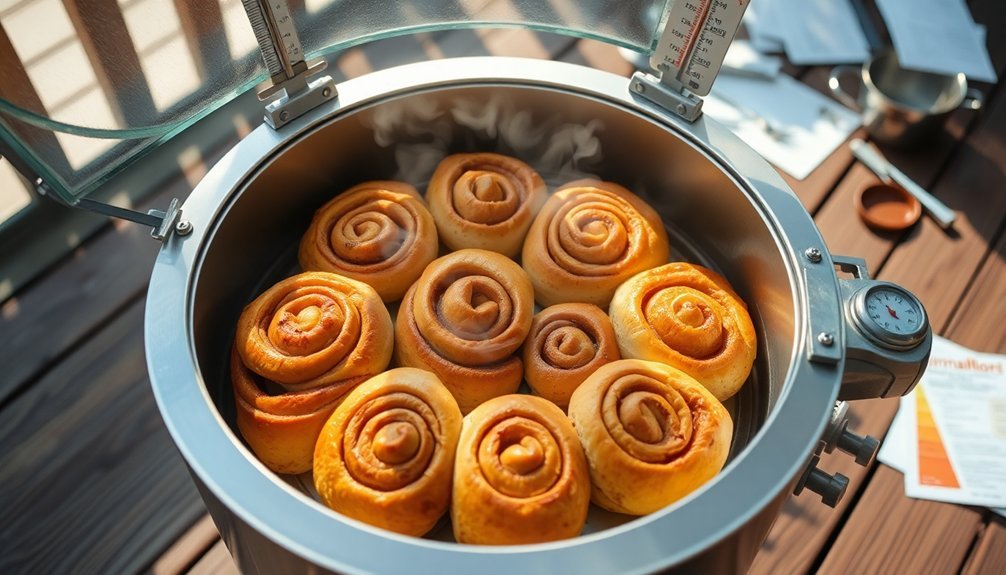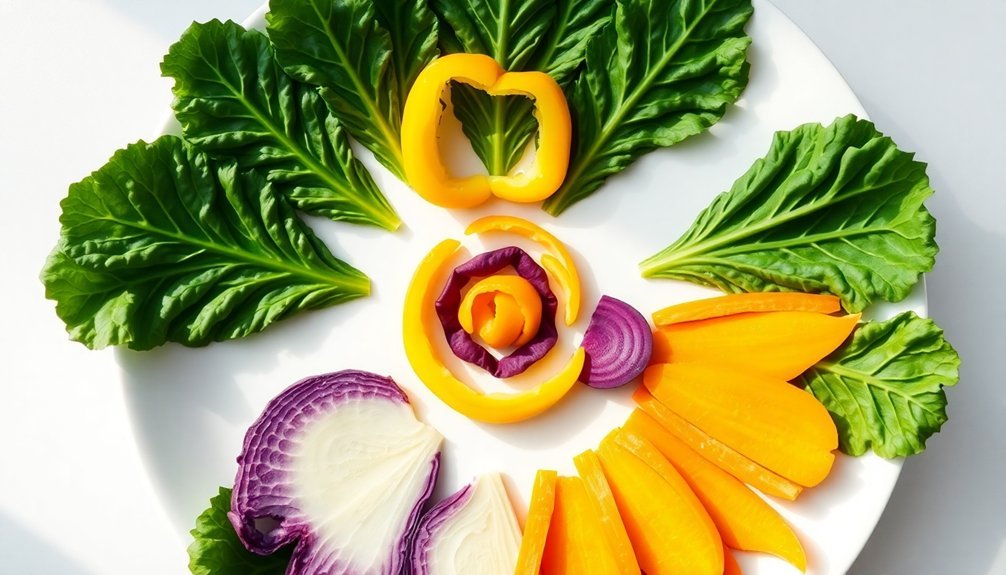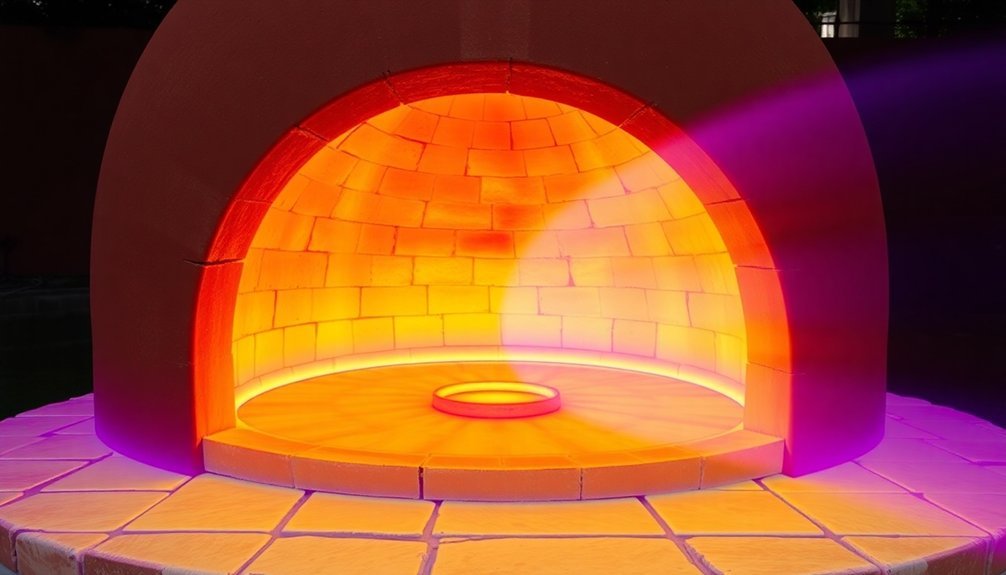You'll find three reliable methods for baking cinnamon rolls using solar power. The Classic Sun Oven Technique delivers consistently moist results at 340°F with proper dough preparation and 30-40 minutes of baking time. The Basic Box Solar Method uses a DIY approach with two cardboard boxes, aluminum foil, and black paint to reach 350°F in just 20 minutes. For maximum efficiency, try the Enhanced Multiple-Reflector Setup, which uses adjustable reflectors to capture more sunlight and maintain steady temperatures. Each method requires attention to sunlight conditions and proper insulation, but mastering these techniques will reveal the perfect solar-baked treat.
Classic Sun Oven Technique

The Classic Sun Oven Technique for cinnamon rolls takes advantage of natural sunlight to create perfectly baked treats.
You'll start by preparing your dough using whole wheat flour, essential wheat gluten, instant yeast, hot water, salt, oil, honey, and lemon juice. Mix and knead these ingredients until you achieve a smooth texture.
Once your dough is ready, divide it into portions (about 1/6 of the total dough per roll). Roll each portion to 1/2 inch thickness, then spread a light coating of honey followed by your brown sugar and cinnamon mixture. Roll the dough into a log and cut it into slices using dental floss or a sharp knife.
Position your Sun Oven in direct sunlight and preheat it to reach at least 350 degrees. Place your rolls in a dark-colored pan, which helps absorb heat better, and leave space between them for rising.
You'll need to bake them for 30-40 minutes at 340 degrees or higher, though cooking time may increase if temperatures are lower. The Sun Oven's moisture-retaining properties will guarantee your rolls stay soft and moist throughout the baking process. Once baked, check for proper consistency before application of any toppings or icing.
Basic Box Solar Method
While the Classic Sun Oven offers a commercial solution, you can create your own solar oven using readily available materials from home. You'll need two cardboard boxes of different sizes, aluminum foil, plastic wrap, black paint or paper, and basic insulation materials like newspaper.
Start by cutting a flap in the outer box's lid and line it with reflective aluminum foil to direct sunlight into your oven. Create an opening in the top box that'll accommodate your inner box, which should be painted black to serve as a heat sink. Cover the inner box's bottom with aluminum foil for additional heat reflection.
Place the smaller box inside the larger one, ensuring there's space between them for insulation. Fill the gap between boxes with newspaper for better heat retention, then seal the top opening with plastic wrap to create a greenhouse effect.
When baking cinnamon rolls, you'll want to preheat your solar oven in direct sunlight. Your homemade solar oven can reach 350°F in 20 minutes with proper sun alignment. Place your prepared rolls in a suitable baking pan, and let them rise before baking. They'll need about 30-45 minutes to cook through and achieve a golden-brown finish.
Enhanced Multiple-Reflector Setup

Building upon the basic box design, multiple reflectors dramatically boost your solar oven's efficiency and cooking speed.
You'll want to position reflectors on the sides and top of your oven, making sure they're adjustable to capture maximum sunlight throughout the day. Cut your reflector panels from sturdy cardboard and cover them with aluminum foil, shiny side out, securing it firmly with duct tape.
Set up your reflectors at different angles – steeper at the top and shallower at the bottom – to direct sunlight right into the cooking chamber. Using a high heat spray on interior surfaces ensures maximum heat absorption.
You'll need to align the top reflector so its rays hit the opposite side of your target area. Use a protractor to measure these angles precisely, and drill holes in the corners of your reflectors for easy attachment.
Create slots or flaps on your outer box to hold the reflectors securely while allowing for adjustments. Connect them using twist ties for flexibility, and add small wooden supports on the back for stability.
Don't let your reflectors block the oven door or vent. Test different positions until you find the ideal setup that directs the most sunlight onto your cinnamon rolls.
Frequently Asked Questions
Can I Use Regular All-Purpose Flour Instead of Whole Wheat Flour?
Yes, you can use all-purpose flour instead of whole wheat flour! You'll need less liquid since it absorbs less water, but you'll get softer, lighter cinnamon rolls that are easier to shape and knead.
How Do I Prevent the Cinnamon Rolls From Sticking to the Pan?
Line your pan with parchment paper or foil, and brush it with oil or butter. You'll also want to let the rolls cool for 10 minutes before removing them. Don't forget to space them properly while baking.
What's the Minimum Sun Exposure Needed for Successful Cinnamon Roll Baking?
You'll need at least 3-4 hours of direct sunlight during peak hours (10am-2pm) to successfully bake your rolls. Make sure there's minimal cloud cover to maintain the required 340°F temperature.
Can I Prepare the Dough the Night Before Solar Baking?
Yes, you can prepare your dough the night before! Let it rise overnight, covered with a damp towel. In the morning, you'll knead, roll, and fill it before baking in your solar oven.
Will Humidity Affect the Baking Time of Solar Oven Cinnamon Rolls?
Yes, humidity will extend your baking time since you'll need to wipe condensation from the glass lid frequently. You'll also want to leave a small gap for moisture to escape during the baking process.
In Summary
You've now learned three reliable methods for baking delicious cinnamon rolls using solar power. Whether you opt for the traditional Sun Oven, create a basic cardboard box setup, or build the advanced multi-reflector system, you'll be able to harness the sun's energy to make fresh, warm treats. Just remember to monitor weather conditions and position your oven correctly for best results.





Leave a Reply